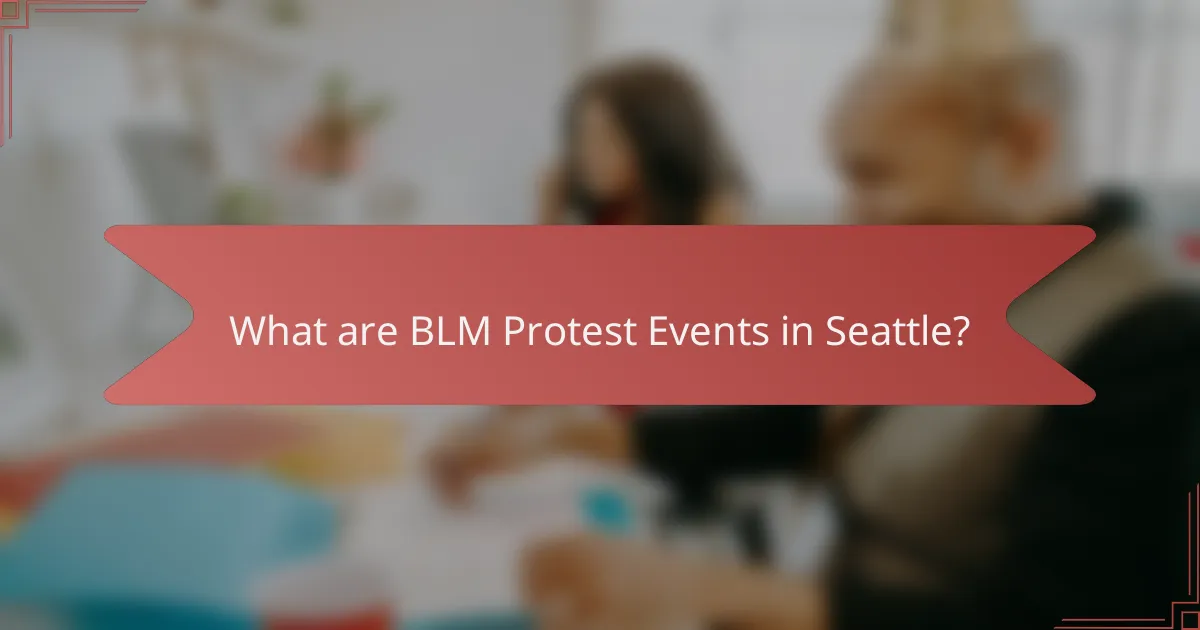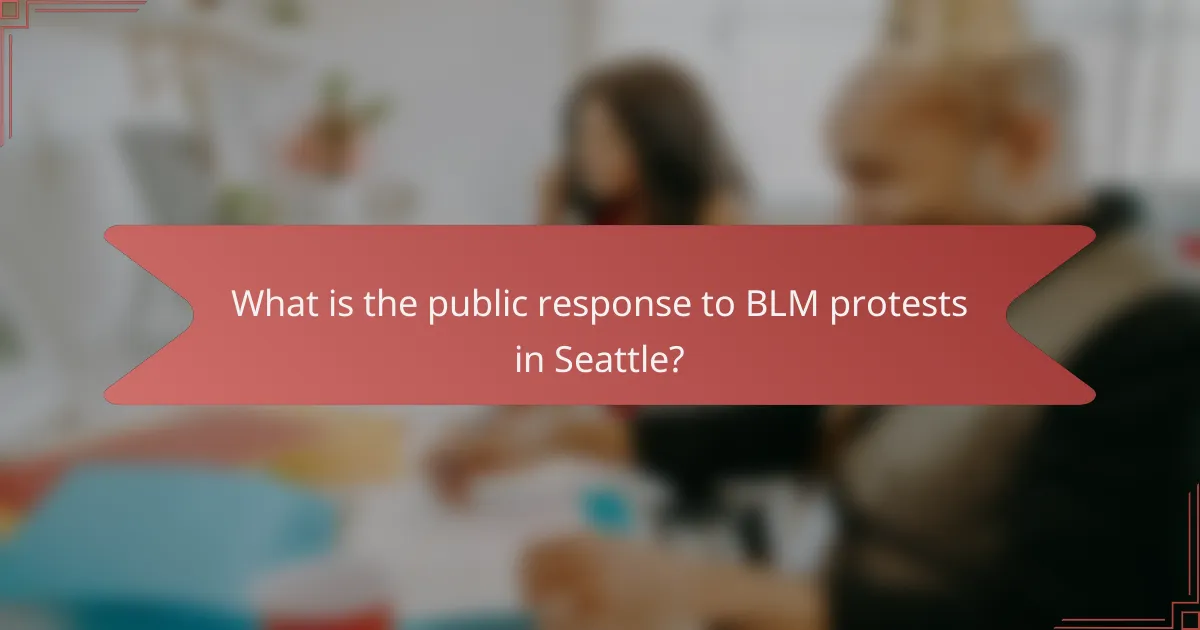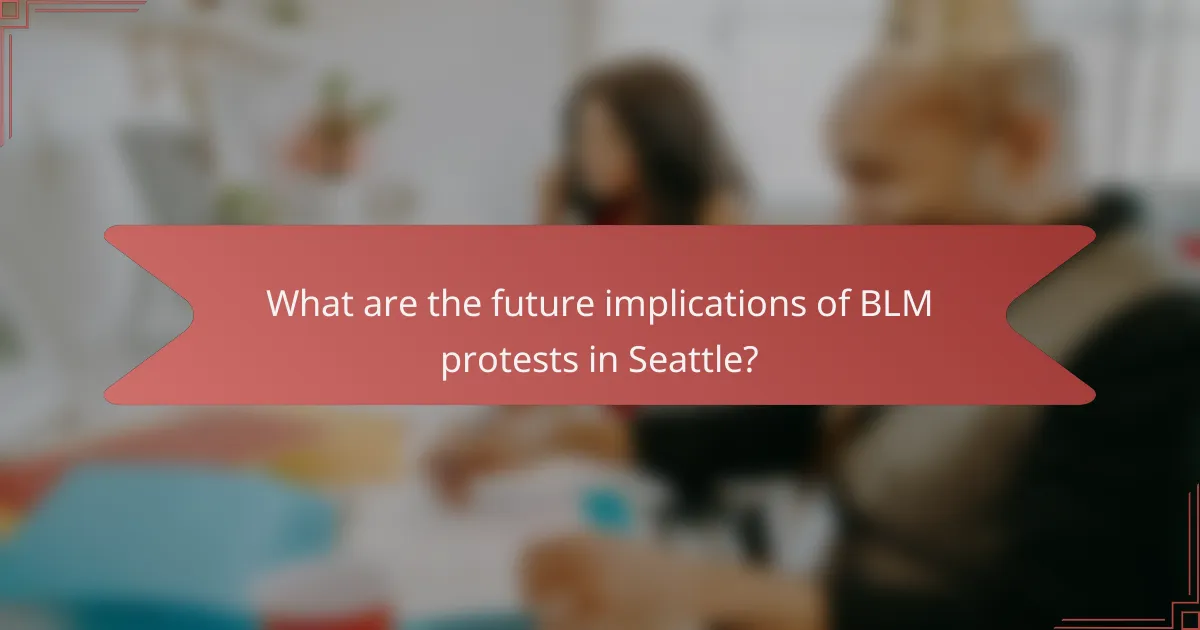
What are BLM Protest Events in Seattle?
BLM protest events in Seattle are organized demonstrations advocating for racial justice and police reform. These events gained momentum following the death of George Floyd in May 2020. Notable protests occurred in locations such as Capitol Hill and Seattle City Hall. Participants often engage in marches, speeches, and community discussions. The events aim to raise awareness about systemic racism and police violence. Seattle’s protests have drawn thousands of participants, showcasing community solidarity. Local organizations frequently coordinate these events to maximize impact and outreach. The city has experienced both peaceful demonstrations and instances of unrest during these protests.
What is the historical context of BLM protests in Seattle?
The historical context of BLM protests in Seattle is rooted in the city’s long-standing issues with racial inequality and police violence. The protests gained significant momentum following the killing of George Floyd in May 2020. This event sparked nationwide outrage and led to widespread demonstrations in Seattle. The city has a history of activism, particularly around civil rights and social justice issues. Previous incidents, such as the fatal police shooting of Charleena Lyles in 2017, also fueled public dissent. Seattle’s protests were characterized by calls for police reform and accountability. Activists utilized social media to organize and amplify their message. The protests often centered around key locations, including Capitol Hill and the Seattle Police Department’s East Precinct. These events highlighted the ongoing struggle for racial justice in the city. The protests in Seattle were part of a larger national and global movement advocating for systemic change.
How have previous events shaped current protests?
Previous events have significantly influenced current protests by establishing a framework for activism. Historical injustices, such as police brutality and systemic racism, have galvanized communities. The Black Lives Matter movement emerged as a response to high-profile cases like the deaths of Trayvon Martin and George Floyd. These events sparked national outrage and mobilized diverse groups to advocate for change. Seattle’s protests have been shaped by the city’s history of civil rights activism. The legacy of earlier movements has provided strategies and solidarity among protesters. Local incidents, such as the police killing of Charleena Lyles, have further intensified community responses. The accumulation of these events has created a sustained demand for justice and reform.
What key events have defined the BLM movement in Seattle?
The Black Lives Matter (BLM) movement in Seattle has been defined by several key events. The protest following the death of George Floyd in May 2020 marked a significant moment. This event sparked widespread demonstrations across the city. Protesters gathered in large numbers at locations like Capitol Hill and Seattle City Hall. The establishment of the Capitol Hill Organized Protest (CHOP) zone became a notable development. CHOP served as a focal point for activism and community discussions. Additionally, the involvement of local organizations and leaders shaped the movement’s direction. The Seattle Police Department’s response to protests also drew significant attention. These events collectively highlight the impact of the BLM movement in Seattle.
What are the significant locations for BLM protests in Seattle?
The significant locations for BLM protests in Seattle include Capitol Hill, Westlake Park, and the Seattle Police Department’s East Precinct. Capitol Hill became a focal point for protests starting in May 2020. Westlake Park has hosted numerous gatherings and marches. The East Precinct was a site of significant confrontations and was eventually boarded up during protests. These locations are central to the movement’s visibility in Seattle.
Which locations are most frequently associated with BLM events?
The locations most frequently associated with BLM events include Seattle’s Capitol Hill, Westlake Park, and the Seattle City Hall. Capitol Hill has been a central hub for protests due to its historical significance in social movements. Westlake Park serves as a gathering point for rallies and demonstrations. Seattle City Hall is often a focal point for civic engagement and public discourse. These areas have hosted numerous events, reflecting the city’s active involvement in the BLM movement.
What role do these locations play in the overall movement?
The locations in Seattle play a crucial role in the Black Lives Matter (BLM) movement. They serve as gathering points for protests and demonstrations. These sites foster community engagement and solidarity among participants. Key areas like Capitol Hill and Seattle City Hall have historical significance in civil rights activism. They symbolize resistance and provide visibility for the movement’s messages. The choice of locations amplifies the movement’s reach and impact. By utilizing prominent public spaces, the BLM movement draws attention from media and passersby. This visibility is essential for raising awareness about racial injustice and police brutality.
How do environmental considerations impact BLM protests in Seattle?
Environmental considerations significantly impact BLM protests in Seattle. Activists often highlight the intersection of racial justice and environmental issues. Protests frequently address climate change, pollution, and urban development. These factors disproportionately affect marginalized communities. For instance, neighborhoods with higher populations of people of color often experience greater environmental hazards. This connection amplifies the urgency of the protests. Additionally, the presence of green spaces is a focal point during demonstrations. Protesters advocate for equitable access to these areas. Overall, environmental considerations shape the narrative and goals of BLM protests in Seattle.
What are the environmental implications of protest activities?
Protest activities can have significant environmental implications. These implications include increased waste production from signs, banners, and food packaging. Protests often lead to soil compaction and vegetation damage in public spaces. Noise pollution from large crowds can disrupt local wildlife. Traffic disruptions can lead to increased vehicle emissions in the area. Additionally, if protests involve road blockages, emergency services may face delays, potentially impacting environmental safety. Studies indicate that mass gatherings contribute to both short-term and long-term ecological effects in urban areas.
How do protesters address environmental concerns during events?
Protesters address environmental concerns during events by promoting sustainable practices. They often advocate for reduced waste generation, such as using reusable materials. Many protesters also emphasize the importance of eco-friendly transportation options. For example, they may encourage carpooling or public transit to minimize carbon footprints. Additionally, protesters frequently raise awareness about specific environmental issues. This includes highlighting the impact of climate change on marginalized communities. They may distribute informational materials that educate attendees on environmental justice. Organizers often collaborate with local environmental groups to amplify their message. During events, they may also incorporate eco-conscious messaging into speeches and banners.

What is the public response to BLM protests in Seattle?
The public response to BLM protests in Seattle has been mixed. Many residents have shown strong support for the movement. They participated in marches and demonstrations advocating for racial justice. However, there have also been significant counter-protests. Some community members expressed opposition to the methods used during the protests. Incidents of property damage and clashes with law enforcement have raised concerns. Public opinion varies based on personal experiences and media narratives. According to a survey by the Seattle Times, a majority of respondents supported the goals of the protests. Yet, concerns about safety and law enforcement response have also been highlighted.
How has the community reacted to BLM events?
The community has reacted to BLM events with a mix of support and opposition. Many residents participated in protests, advocating for racial justice and police reform. Local organizations have mobilized to support the movement through donations and resources. However, there have also been counter-protests opposing BLM initiatives. Certain community members expressed concerns about the impact of protests on public safety and local businesses. In Seattle, the protests led to significant discussions about systemic racism and police practices. The community’s engagement has resulted in increased awareness and dialogue around these issues.
What are the differing perspectives within the Seattle community?
The Seattle community has varying perspectives on the BLM protest events. Some residents support the protests, viewing them as essential for social justice and racial equality. They believe that these events raise awareness about systemic racism and police brutality. Conversely, other community members express concern about the protests leading to violence and property damage. They argue that such actions undermine the message of the movement. Additionally, some individuals feel that the protests disrupt daily life and local businesses. This divide reflects broader national discussions about race, justice, and civic action. The differing perspectives highlight the complexity of community sentiment regarding social movements.
How do public responses vary across different demographics?
Public responses to BLM protest events in Seattle vary significantly across different demographics. Factors such as age, race, and socioeconomic status influence these responses. Younger individuals tend to express more support for protests compared to older demographics. Racial minorities often engage more actively due to personal experiences with systemic racism. In contrast, some white populations may show mixed feelings, balancing support with concerns about property damage. Additionally, lower-income groups may prioritize social justice issues more prominently than higher-income individuals, who might focus on economic stability. Research indicates that demographic factors can shape perceptions and engagement levels during social movements.
What actions have local authorities taken in response to protests?
Local authorities in Seattle have implemented various actions in response to protests. They have enforced curfews during heightened unrest. Law enforcement has utilized tear gas and rubber bullets to disperse crowds. Authorities have also established designated protest zones to manage gatherings. Additionally, city officials have engaged in dialogue with community leaders. They have increased police presence in areas with frequent protests. Seattle’s mayor has publicly addressed demands for police reform. These actions reflect the city’s attempt to balance public safety and the right to protest.
What measures have been implemented to manage protests?
Measures implemented to manage protests include increased police presence and crowd control tactics. Authorities have utilized barriers to delineate protest areas. Communication with protest organizers has been established to ensure safety. Local government has enforced curfews during heightened tensions. Emergency services have been on standby to respond to incidents. De-escalation training for officers has been prioritized. Surveillance technologies have been deployed to monitor protest activities. These measures aim to balance public safety and the right to protest.
How have law enforcement practices evolved during BLM events?
Law enforcement practices have evolved significantly during Black Lives Matter (BLM) events. Initially, police responses included aggressive tactics such as tear gas and rubber bullets. Over time, there has been a shift towards de-escalation strategies and community engagement. Many departments adopted policies to limit the use of force and emphasize communication. For instance, the Seattle Police Department implemented a new crowd management policy in response to public outcry. This policy aimed to prioritize the safety of protesters and reduce confrontations. Furthermore, some law enforcement agencies began to collaborate with community organizations for better conflict resolution. Data from various protests indicate a marked decrease in violent encounters as these practices were adopted. Overall, the evolution reflects a growing recognition of the need for reform in policing methods during protests.

What are the future implications of BLM protests in Seattle?
The future implications of BLM protests in Seattle include ongoing discussions about racial justice and police reform. These protests have highlighted systemic issues within law enforcement. The city may implement changes to policing practices as a response. Increased community engagement is likely to occur in policymaking. Additionally, local government may face pressure to address economic disparities. Public awareness of racial inequality will likely remain high. Educational initiatives around these issues may expand in schools. Overall, the protests have set a foundation for continued activism and dialogue.
How might BLM protests influence local policy changes?
BLM protests can significantly influence local policy changes by raising public awareness and prompting community discussions. These protests often highlight systemic issues, such as racial injustice and police violence. As communities mobilize, local leaders may feel pressure to address these concerns. This pressure can lead to policy proposals aimed at reforming law enforcement practices. For example, cities may implement measures like increased police accountability or changes in use-of-force policies. Historical instances, such as the protests following George Floyd’s death, have resulted in tangible policy shifts in various cities across the U.S. Local governments may also initiate community dialogues to better understand constituents’ needs. These discussions can foster a collaborative approach to policy-making, reflecting the demands of the protesters.
What are potential outcomes of ongoing protests for Seattle’s communities?
Ongoing protests in Seattle can lead to various outcomes for the communities involved. Increased community engagement is one potential outcome, as residents may become more involved in local governance and activism. Economic impacts may also arise, with businesses facing disruptions but potentially benefiting from increased foot traffic during peaceful protests. Social cohesion can strengthen among like-minded individuals advocating for change. However, tensions may escalate between opposing groups, leading to conflicts. Public policy changes may occur, influenced by the demands of protestors. Increased awareness of social justice issues can foster broader community discussions. Lastly, the long-term effects on public perception of law enforcement and government may reshape community relations.
What can participants do to enhance the impact of BLM protests?
Participants can enhance the impact of BLM protests by actively engaging in organized actions. They should educate themselves on racial justice issues and share this knowledge with others. Building community solidarity is crucial, as collective voices amplify the message. Participants can also utilize social media to raise awareness and mobilize support. Attending protests consistently demonstrates commitment and can influence public opinion. Supporting local Black-owned businesses contributes to economic empowerment. Additionally, participants can advocate for policy changes by contacting local representatives. These actions collectively strengthen the movement’s visibility and effectiveness.
What strategies can individuals adopt to support the movement effectively?
Individuals can adopt several strategies to support the Black Lives Matter (BLM) movement effectively. Participating in protests is a direct way to show solidarity. Engaging in community organizing helps build local support networks. Donating to BLM-affiliated organizations provides crucial financial resources. Educating oneself and others about systemic racism fosters informed discussions. Amplifying marginalized voices on social media raises awareness. Volunteering for local initiatives strengthens community ties. Supporting Black-owned businesses promotes economic equity. These actions collectively contribute to the movement’s goals and visibility.
How can community members engage with local leaders on these issues?
Community members can engage with local leaders through organized forums and town hall meetings. These events provide a platform for direct dialogue. Members can voice their concerns and propose solutions. Additionally, participating in local advocacy groups strengthens community connections. Engaging on social media can amplify voices and issues. Writing letters or emails to local representatives is another effective method. Attending community board meetings allows for direct interaction with decision-makers. Research shows that active community involvement leads to more responsive leadership. Engaging locally fosters a sense of ownership and accountability in addressing issues.
BLM protest events in Seattle are organized demonstrations advocating for racial justice and police reform, particularly following the death of George Floyd in May 2020. Key locations for these protests include Capitol Hill, Seattle City Hall, and Westlake Park, which serve as focal points for community engagement and activism. The article explores the historical context of these protests, significant events that have shaped the movement, public responses, and the environmental implications associated with protest activities. Additionally, it discusses the varying perspectives within the community and the actions taken by local authorities in response to the protests, highlighting the potential future implications for Seattle’s policies and community dynamics.